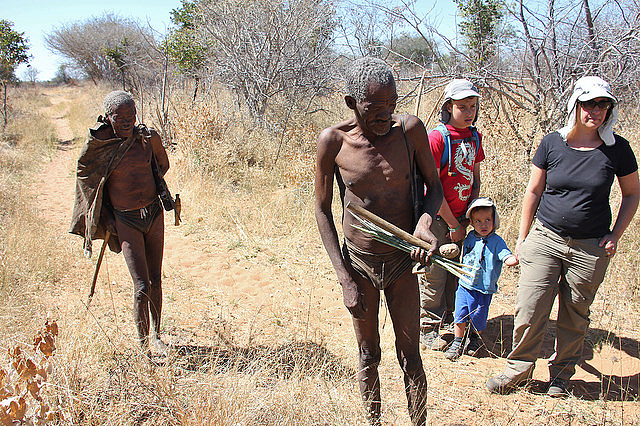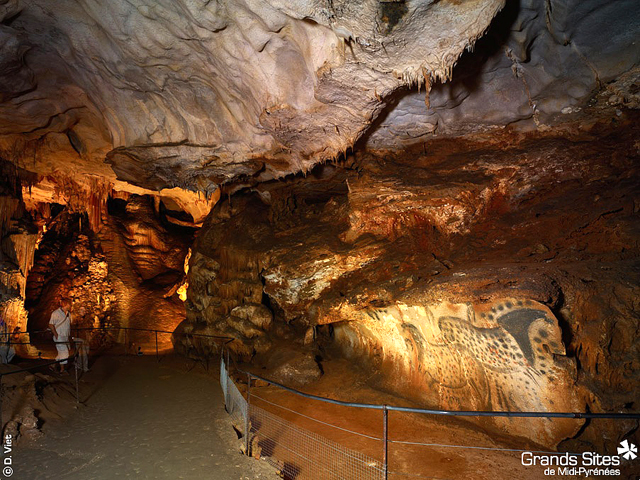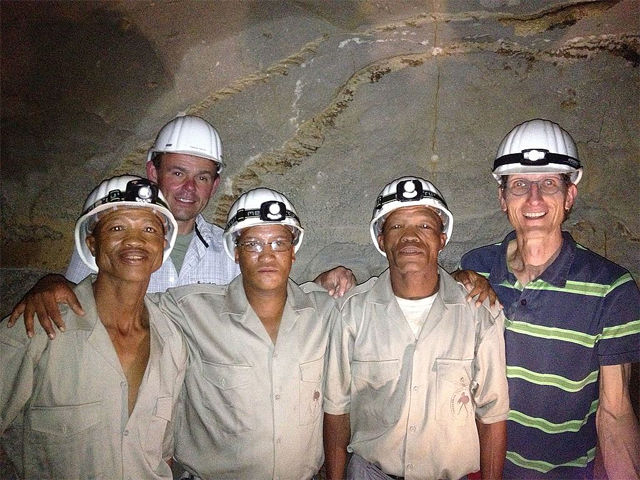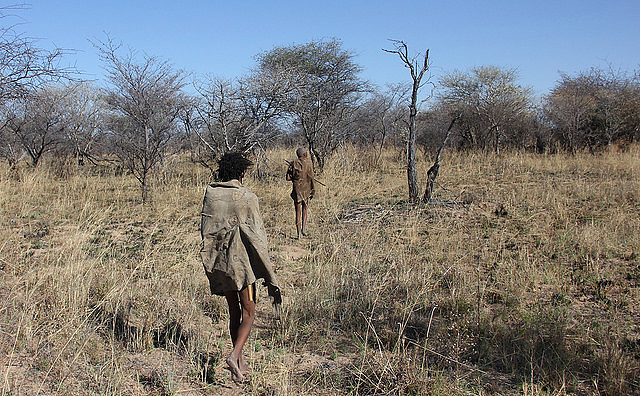Lorna Marshall (1960) pointed out that since all Ju/’hoansi have unique footprints, every member of a band could instantly recognize who has been doing what—so stealing was nearly impossible. The thief would be immediately known and dealt with. In other words, their famed ability as trackers was not only essential to their hunting successes, it also had very real implications for helping them maintain their social stability and their culture of nonviolence.

Another anthropologist, Lee (1979), devoted several pages in a book to a detailed description of their techniques for tracking game animals. He summed up their skill with superlatives: The Ju/’hoansi “are such superb trackers and make such accurate deductions from the faintest marks in the sand that at first their skill seems uncanny (p.212).” He described their ability to recognize the unique footprints of other humans and of course all the animals that lived in the Kalahari Desert—their age, sex, physical condition, and what they had been doing—all by studying their tracks.
A group of archaeologists in Germany decided to see if the famed tracking skills of the San people could help them unwrap some mysteries surrounding footprints made by prehistoric people preserved in four European caves, including the famous Pech-Merle. This 2013 project brought three expert Ju/’hoansi trackers—Tsamkxao Ciqae, Ui Kxunta, and Thui Thao—from Namibia to France so they could examine the Pleistocene footprints. Their study of the evidence yielded remarkable results and some interesting news coverage. The scholars who brought the Ju/’hoan trackers to Europe recently published a journal article (Pastoors et al, 2017) describing in detail the work of the trackers: how they analyzed the footprints in the Pech-Merle cave, their results, and the conclusions they reached. The three Ju/’hoansi men are listed as co-authors of the article.

Pech-Merle cave in southwestern France has a fascinating gallery of late Pleistocene rock art—and, incidentally, some human footprints preserved in the soft earth in one small area of about 9 square meters. A thin layer of calcite has formed over the footprints but enough details are preserved to permit in-depth studies of the movements of the people who made them. A spot of charcoal from one of the cave paintings dates from about 25 to 29 thousand years ago but the footprints have not been dated as accurately.
The three Ju/’hoansi men inspected the footprints in Pech-Merle and the three other caves with known human tracks. The point was to integrate their indigenous knowledge with the data and analysis proposed and published earlier by European archaeologists. Pastoors and his colleagues were not interest in romanticizing the indigenous knowledge of the San people nor in looking at the footprints from another, more exotic, viewpoint. Instead, they sought alternative interpretations of data that is widely available. The authors argued that expert tracking, for the purposes of hunting wild game animals, is based on real narratives of real events in the lives of animals; it is also based on an in-depth knowledge of conditions prevailing in the ecosystem.

The three Ju/’hoansi men examined the footprints to determine the ages of the makers, their pace, posture, foot positions, sex, and gait. For readers curious about the ways those experts analyzed the footprints, the authors described, with an accompanying diagram of a right foot, the various factors that go into forming their judgments as to exactly who was making a footprint and what he or she was doing at that moment.
The Ju/’hoansi experts used other factors as well. They differentiated among differing foot postures by assigning categories such as light inward twist or developed inward twist, or light or developed outward twist, or parallel postures. They estimated characteristics such as the age of the person from the presence or absence of cracks in the skin and the apparent flexibility of the toes. The authors argued that the discriminating analytical methods used by the trackers overlap with the measurement approaches used by archaeologists. However, it is apparent from the article that the superior knowledge and experience of the Ju/’hoan men about tracking gave them a decided advantage over efforts by earlier European scientists.
The visit by the Ju/’hoansi yielded a lot of new information to the existing literature about the tracks in Pech-Merle. For one thing, previous scholars who had examined the floor of the cave had identified from 4 to 12 discrete footprints. The Ju/’hoansi found five more, for a total of 17 separate footprints. Furthermore, they identified five discrete, barefoot individuals who had made the tracks, as follows. One was a man of about 34 or 35 who left a single right footprint. The second person, a 25-year old woman, was walking fairly slowly, a conclusion the trackers reached when they discovered a second footprint made by her so they could easily estimate her walking pace.

The third person who left footprints was a 9 or 10 year old boy. Earlier scholars had seen two prints by the boy but the Ju/’hoansi trackers found a third footprint he had made. They concluded that the boy had been walking in a westerly direction but had changed his pace as he turned more toward the west-northwest. The authors pointed out that the probable reason the boy had changed direction and accelerated his speed may have been to avoid a nearby abyss and to get closer to the safety of the cave wall. Only one footprint had been identified as made by a fourth subject, but the trackers found a second and were able to determine that they were made by an older man, over 50 years of age, who was walking at a fast pace.
The fifth subject was a 30-year old woman. From the fact that one of her footprints was a deep one, the Ju/’hoansi concluded that she was probably carrying a load of some kind. Once again, the trackers were the first to discover another footprint she had made. In sum, the Ju/’hoansi men concluded that they had seen the tracks of five different people, two men, two women, and one boy.
The authors deal with a question that many readers would ask: why did previous investigators miss so many footprints that were obvious to the Ju/’hoansi? They answer: “It remains unclear why they were overlooked or ignored by the preceding researchers.” They add, perceptively, “Once pointed out by Ciqae, Kxunta and Thao, they were distinctly visible (p.160).”
Without directly criticizing the earlier scholars, it is clear to the reader that the biggest problem for the archaeologists who had done the previous examinations of the cave footprints was that they had not correctly distinguished the tracks made by one individual from those made by another. Previous researchers saw only one individual, or at most two. The Ju/’hoansi experts decided how many individuals had made the tracks so they could then analyze exactly what they were doing in the cave: e.g., a woman carrying some sort of a load.
The fascination of all this is learning how well the Ju/’hoansi preserve their traditional tracking skills, even as they now do less hunting and more herding in their villages. The unanswered question is if they still have ways to identify thieves by studying their footprints.
Pastoors, Andreas et al. 2017. “Experience Based Reading of Pleistocene Human Footprints in Pech-Merle.” Quaternary International vol. 430, part A (Feb. 12): 155-162